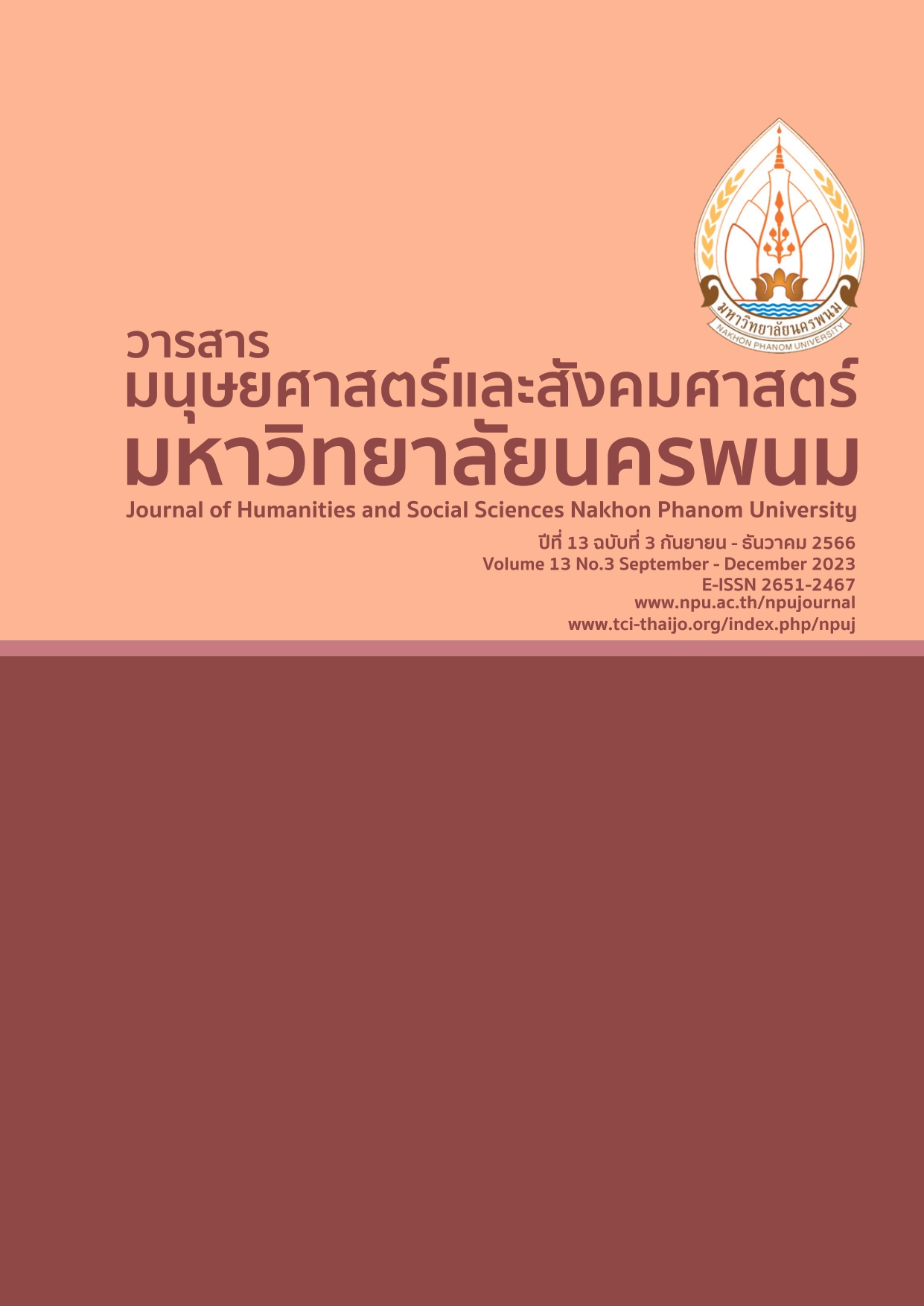Assessing the Social Return on Investment for the Cultural Entrepreneurship Development Project in Traditional Candle Making in the Old City Neighborhood of Ubon Ratchathani Province
Main Article Content
Abstract
The purpose of this research was to assess the social return on investment (SROI) for the cultural entrepreneurship development project in traditional candle making in the old city neighborhood of Ubon Ratchathani Province. The methodology involved observational methods and in-depth interviews with key stakeholders, particularly cultural entrepreneurs. The sample size was determined using convenience sampling. The participants were 11 cultural entrepreneurs who attended and chose to provide information for the project. The research instruments consisted of questionnaires, in-depth interviews, semi-structured interviews, and focus group discussions. The results found that the social return on investment (SROI) was at 3.46, which showed that each baht of investment in research could create a return to the entrepreneurs both in societal value and economic value of 3.46 baht. Therefore, this research budget is worthily spent and can contribute to society. The principle-based policy recommendation suggests the SROI assessment framework from this article should be applied to other organizations’ activities or projects in order to assess the worthiness of investment. that conduct activities aimed at assessing the value of investments. Other cultural entrepreneurs or related organizations can apply the pattern of this cultural capital-enhancing activity as a guideline for Other cultural entrepreneurs or related organizations can apply the pattern of this cultural capital-enhancing activities as a guideline for organizing project activities for promoting occupation or tourism in the area to spread around to protect the capital concentration and build up the community potential to be able to become cultural entrepreneurs of people in the area.
Article Details

This work is licensed under a Creative Commons Attribution-NonCommercial-NoDerivatives 4.0 International License.
References
Aphibunyopas, J. and Klamsaengsai, S. (2020). kān songsœ̄m læ phatthanā thurakit mūbān tham mā
khākhāi : kō̜ranī sưksā wisāhakit chumchon klum thō̜ phāya ʻom sī thammachāt nō̜ng būa dǣng
ʻamphœ̄ nō̜ng būa dǣng čhangwat Chaiyaphūm [Development of Promotion and development of
village businesses: a case study. Nong Bua Daeng Natural Dye Weaving Group Community Enterprise
Nong Bua Daeng District Chaiyaphum Province]. Thai Tourism Journal International. 16(2). 1-21
Aiphong, T. (2020). kānmī sūanrūam khō̜ng chumchon nai kānbō̜rihān čhatkān pā chumchon bǣp yangyư̄n
nai tambon mǣ thā ʻamphœ̄ MǣʻŌ̜n čhangwat Chīang Mai [Development of Community
participation in sustainable community forest management in Mae Tha Subdistrict], Mae On
District. Chiang Mai Province. Retrieved January 2022, from https://cmudc.library.cmu.ac.th/frontend/Info/item/dc:160872
Creighton, J. L. (2005). The public participation handbook: Making better decisions through citizen
involvement. United States: Jossey-Bass.
Khieograe, A., Ua-ankun, A., Thongmee, P., Krutjon, T., and Sirisathitkit, C.S. (2020). kānphatthanā
sakkayaphāp læ phœ̄m khīt khwāmsāmāt dān kān khǣng khan khō̜ng wisāhakit rōngsīkhāo chum
chon bān nō̜ng ʻōn tambon khūan rū ʻamphœ̄ rat phūm čhangwat Songkhlā [Development of
Development Potential and increasing the competitiveness of the Ban Nong Oon community rice
mill enterprise, Khuan Ru Subdistrict, Rat District Phum Songkhla Province. National Research
Council (NRCT) and the National Research Council of Thailand (NRCT) and the National Research
Council of Thailand Innovation (NRCT).
Kongmanee, C., Satsue, P. and Pittayapinan, P. (2018). phontō̜pthǣn thāng sangkhom čhāk kānlongthun
khō̜ng khrōngkān wičhai thāng witthayāsāt nai chut khrōngkān kānphatthanā ʻutsāhakam yāngphārā
[Development of Social returns from investments of Scientific research project in the rubber
industry development project series]. Management Journal Modernism, 16(2), 44-56
Martins, T., Braga, A., Braga, V., and Ferreira, M. R. (2020). The social innovation Momentum: A
qualitative analysis of governance and funding processes. International Review on Public and Nonprofit Marketing, 17(1), 97–120.
Naksenee, T., Saengkhae, R. and Phithak, A. (2022). phontō̜pthǣn thāng sangkhom čhāk kāndamnœ̄n
thurakit wisāhakit chumchon phư̄a songsœ̄m kānthō̜ngthīeo chœ̄ng kīlā nai kānčhat ngān wing
čhō̜m bưng mā rā thō̜ ʻon kō̜ranī sưksā sūn kānrīanrū yū yen pensuk withī Thai Rāman [Development of Social returns from business operations. Community enterprise to promote sports tourism in organizing the Chom Bueng Marathon, case study center Learning is cool and happy]. Thairaman way. Lawasri Journal, Thepsatri Rajabhat University. 6(1). 88-105
National Innovation Agency, Thailand. (2020). Sroi Calculator. Retrieved October 25, 2022, from
https://sroi-calculator.nia.or.th.
Office of the National Economic and Social Development Council. (2022). Gross Domestic
Product Chain Volume Measures 1/2023. Retrieved on January 2022, from https://www.nesdc.go.th/ewt_dl_link.php?nid=13214&filename=QGDP_report.
Osman, A. (2022). Empirical measure of cultural sustainability. Applied Geography, 145. 1-12
https://doi.org/10.1016/j.apgeog.2022.102745
Osterwalder, A. and Pigneur, Y. (2010). Business Model Generation, a guide to creating business models.
United States: Jossey-Bass.
Phasiphon, C. (2017). kānpramœ̄nphon tō̜pthǣn thāng sangkhom [Development of Evaluation of social
Returns]. Journal of Education. 45(4). 343-353
Phongviritthon, K., Panthuri, W., Honglertsakul, C. and Assakan, P. (2024). kānpramœ̄nphon tō̜pthǣn thāng
sangkhom čhāk kānlongthun samrap khrōngkān nawattakam čhāk kan khong bon thān thun thāng
watthanatham khō̜ng chāt phan mong ʻamphœ̄ phop phra čhangwat Tāk [Development of
Assessing the social return on investment for hemp-based innovation projects on a bio-based basis.
Culture of the Hmong ethnic group, Phop Phra District, Tak Province]. Journal of Economics and Business Administration. 16(4). In press.
Raisni, SK. (2020). Planning Business Model Canvas with Swot Method at XYZ Institute. Dinasti
International. Journal of Digital Business Management. 1(5), 781-793.
https://doi.org/10.31933/dijdbm.v1i5.483
Setthasakko, W. (2020). phontō̜pthǣn thāng sangkhom čhāk kānlongthun : kō̜ranī sưksā rōngrǣm rak
singwǣtlō̜m nai prathēt [Development of Thai Social returns from investment: A case study of
an environmentally friendly hotel in Thailand]. Journal of the Accounting Profession. 16(50) , 5-22
Sirilamduan, C., Mudor, H., Komut,W and Musika, K. (2022). phontō̜pthǣn thāng sangkhom čhāk
kānlongthun thāng watthanatham : kān fư̄nfū sinlapa kān sadǣng phư̄nbān [Development of Social returns from cultural investment: restoration Folk performing arts]. Retrieved 30 January 2022, from https://www.ubu.ac.th/web/files_up/00008f2022092210374539.pdf
Social Value Thailand. (2020). SROI 101 Introduction to Social Return on Investment. Retrieved on January
, from https://online.fliphtml5.com/wuiji/eycx/#p=4
Tiberghien, G., and Lennon, J. J. (2022). Managing authenticity and performance in Gulag Tourism,
Kazakhstan. Tourism Geographies, 24(6-7), 1219-1243. https://doi.org/10.1080/14616688.2019.1674371
Tinnakorn, P. (2022). laksūt khanom Thai bư̄angton [Development of Basic Thai dessert course]. Retrieved
On May 2022, from https://www.mlpuang.com/?p=92


